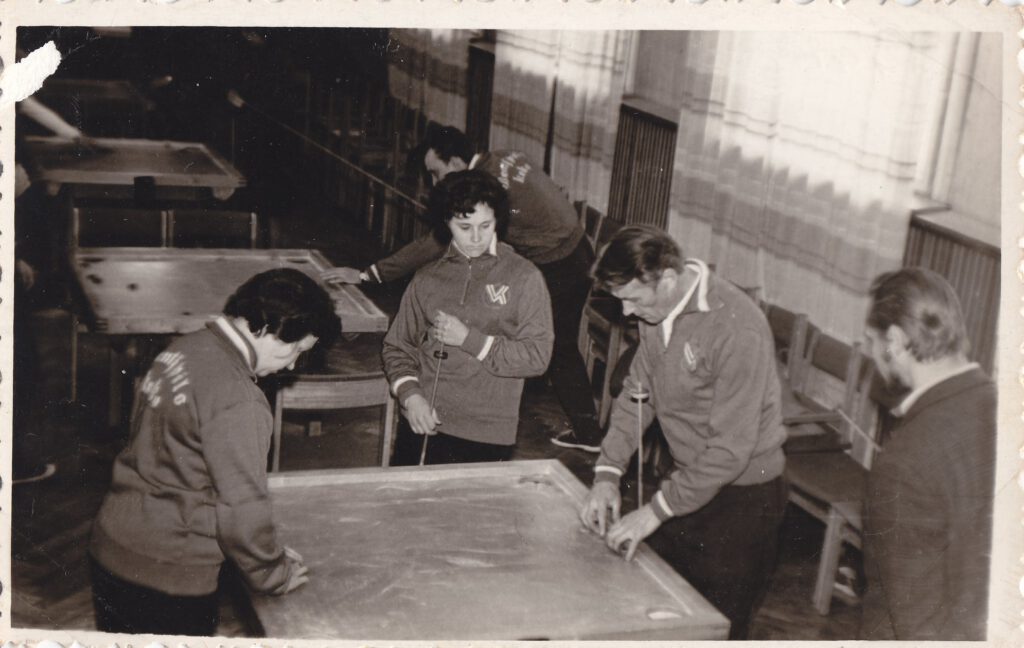About Novuss
HISTORY OF THE DEVELOPMENT OF THE SPORT GAME NOVUSS
As early as the 18th century, Eastern ideas – religious, philosophical, artistic – began to penetrate Europe. The penetration of the East into the West took on a comprehensive character in the 20th century. Mutual cultural influence is primarily reflected in the fields of art and everyday life, that is, in those areas that are capable of easily combining experiences of different cultures.
Europe successfully embraced Eastern cuisine, theatrical traditions, and along with them, board games. To this day, from China to the Middle East, people play a game from which NOVUSS, possibly, originated.

It is known that NOVUSS first appeared in 1925-1927 in Latvia and Estonia. Sailors, visiting English ports in small taverns, played a similar game there. And it was then that the first table was made in Latvia based on sketches taken from England. Tables appeared in the ports of Ventspils, Liepaja, Riga, and Tallinn, where the game NOVUSS, as it was called in Latvia, and KOROONA, as it was called in Estonia, began to develop.
NOVUSS also made an appearance on the big screen. In the movie “Stormbreaker” (2006), in Jackie Chan’s character’s office, a table similar to a table for playing NOVUSS is installed, but it seems to be smaller in size. In the movie “He, She and the Kids” (1986) produced by Riga Film Studio, there is a table for NOVUSS in the apartment of the main character played by Vitaly Solomin. This movie was filmed during the period of the game’s highest popularity in Latvia.
The first tables in Estonia were 80x80cm in size, and athletes from the “KALEV” society competed in this game. However, as the game practice improved, the table sizes were changed, and in 1929, the first industrial batch of game sets was released in Latvia, consisting of 500 copies with a size of 100x100cm, which is the modern standard for game equipment.
In the early years of the development of this sport, there were no unified rules. According to some rules, the winner was the one who scored more pawns in the pockets within a limited time, while according to others, it was the one who scored all the pawns with the fewest number of strikes. It was impossible to compare the skills of athletes. Different variations were consolidated into unified rules, which first appeared in Latvia in 1932. They were issued by P. Tyutenikov. At that time, he wrote that this game had been known in Latvia for 5 years already. It was called “NOVUSS” or “KOROONA,” which once again proves the symmetry of the appearance and further development of this game in Latvia and Estonia.
The first master competitions took place in Riga in 1932. In 1940, there were sports sections for NOVUSS and KOROONA in most higher educational institutions in Tallinn and Riga, as well as in many major industrial enterprises.
After World War II, enthusiasts from the VEF plant started to revive NOVUSS. The first Novuss Federation was formed in Latvia in 1963. Men’s and women’s teams were created. The title of “Sports Master” began to be awarded from 1971. In 1980, over 55,000 people played Novuss in sections throughout Latvia. At that time, Novuss was included in the register of sports of the USSR as a Latvian national sport.
Currently, republican and international competitions are held in Latvia, Estonia, Russia, Ukraine, Belarus, Germany, the United States, Serbia, Finland. In the late 20th and early 21st centuries, the game began to actively develop in Australia, Poland, Georgia, Israel, Canada, Sweden, Czech Republic, France, Italy.
In 2008, the International Federation of Novuss was formed with its headquarters in Cologne, Germany. The founding members of the Federation International of Novuss-Sport Organisations (FINSO) were Latvia, Estonia, Russia, Germany, Ukraine, and Belarus. In 2014, the United States joined FINSO, and in 2016, Finland and other European countries applied for membership.
The beginning of international competitions involving three or more countries took place in 2003. In May 2005, the second European Championship took place in Estonia. In subsequent years, a regular calendar of international rating tournaments – stages of the World Cup – was approved and followed. The culmination of each season is the final tournament of the year, where the best players from international competitions compete for the prestigious title of “Player of the Year”.

